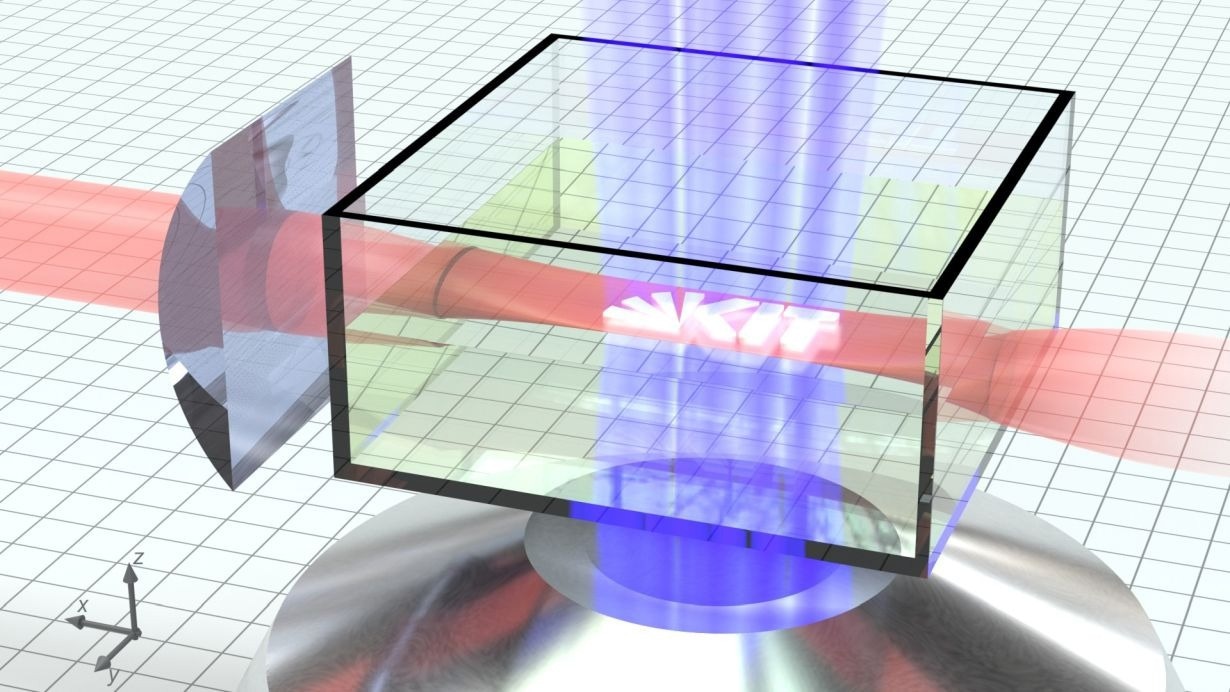Printing objects using plastic rapidly, precisely, and cost-effectively is the focus of numerous three-dimensional (3D) printing processes. Nevertheless, high resolution and speed continue to be technological challenges.

In light sheet 3D printing, red and blue laser light is used to print objects precisely and quickly on a micrometer scale. Image Credit: Vincent Hahn, KIT.
Researchers from the Karlsruhe Institute of Technology (KIT), Queensland University of Technology (QUT), and Heidelberg University are getting close to realizing this goal.
The team formulated a laser printing process capable of printing micrometer-sized parts in the blink of an eye. The work of the international team has been published in the journal Nature Photonics.
Stereolithography 3D printing is presently one of the most prevalent additive manufacturing methods for plastics, both for industrial and private applications. In the stereolithography process, layers of a 3D object are projected individually into a container containing resin. The resin is treated with UV light.
However, earlier stereolithography techniques are not fast and have an extremely low resolution. Light-sheet 3D printing, used by the researchers from KIT, is a rapid and high-resolution substitute.
3D Printing with Two Colors in Two Stages
In the light-sheet 3D printing process, blue light is aimed into a container containing a liquid resin. The blue light pre-stimulates the resin. In the second stage, a red laser beam offers the extra energy required to treat the resin.
Nevertheless, 3D printing can only rapidly print resins that swiftly return from their pre-stimulated state to their primary state. Only then the subsequent layer can be printed. Therefore, the return time regulates the waiting time between two consecutive layers and, consequently, the printing speed.
For the resin we used, the return time was less than 100 microseconds, which allows for high printing speeds.
Vincent Hahn, Study First Author, Institute of Applied Physics, Karlsruhe Institute of Technology
Micrometer-Sized Structures in Just the Blink of an Eye
To make the most of this new resin, the team constructed a dedicated 3D printer. The blue laser diodes of this printer are used to propel images into the liquid resin using a high-resolution display containing a high frame rate.
The red laser is created into a thin “light sheet” beam and passes the blue beam vertically in the resin. With this configuration, the researchers could 3D print micrometer-sized components in a few hundred milliseconds, that is, in the blink of an eye.
But, it must not stop there.
With more sensitive resins, we could even use LEDs instead of lasers in our 3D printer. Ultimately, we want to print 3D structures that are centimeters in size, while maintaining micrometer resolution and high printing speeds.
Martin Wegener, Professor, Institute of Applied Physics, Karlsruhe Institute of Technology
The study was conducted within the context of the joint “3D Matter Made to Order” Cluster of Excellence of the KIT and Heidelberg University. Junior Professor Dr Eva Blasco, a group leader at the Institute of Organic Chemistry and the Institute for Molecular Systems Engineering and Advanced Materials, was involved on the part of Heidelberg University.
Journal Reference:
Hahn, V., et al. (2022) Light-sheet three-dimensional microprinting via two-colour two-step absorption. Nature Photonics. Nature Photonics. doi.org/10.1038/s41566-022-01081-0.